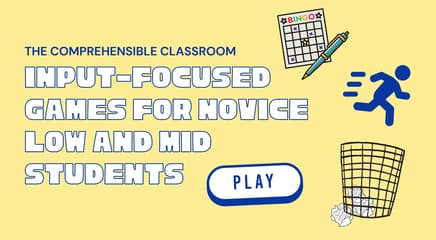
"There is" or "There are" is one of the highest frequency word(s) in any language. In Spanish, the word "hay" is nearly unavoidable as we share stories with our students. Because it is difficult for students to form a mental picture for the word, however, the lack of visualization presents a challenge for getting the word to 'stick' in students brains; for them to acquire it.

Establish meaning for new words
As with any new word or phrase, I begin by establishing meaning for the structure– I tell them what it means by linking meaning to L1. Usually, this happens in writing (I write hay - there is/there are on the board); for pre-literate kids, I suggest telling them what it means verbally and then reminding them several times. I also establish a gesture for it. It is important to give students the English meaning (if they share a common first language) in addition to the gesture so that they do not misinterpret the gesture. My gesture for "hay" is to stand with my hands in front of me, open-palmed and beside each other, and then to dramatically pull them out to the sides, as if presenting something, like, "Here you go! Here it is!"
Contextualize new words
After providing a translation and establishing a gesture, I like to give students a few sample sentences with translations so that they can see it in context. Use cognates and structures that students have already learned, and write out both the original sentence and the translation if kids can read; otherwise, just say them:
- Hay un problema - there is a problem.
- Hay dos dinosaurios - there are two dinosaurs
- ¿Hay un astronauta en el clóset? - Is there an astronaut in the closet?
Use the new word in conversation
Then, begin asking questions that include the new word; in this case, hay. Since this structure will most likely be taught very early in a student's language career, the questions that you can ask are extremely limited. I love this idea for working "there is/there are" into conversation, shared by Carol Gaab, who is a master Comprehension Based teacher, trainer, author, publisher, and one of my personal heroines:

As you begin the activity, you would also need to establish meaning for "sombrero" (hat) and "debajo de" (underneath) to students.
Use the word in games!
After reading Carol's suggestion a few days ago, I happened to stumble across this activity suggestion from Spanish Playground while browsing Pinterest. To adapt it to use with this structure and "upgrade" the game a bit for older students, consider playing like this:
- Lay out a bunch of different candies on a tray. Candies work well because you can talk about them without translating since their names are proper nouns--this limits the vocabulary that students have to focus on. Try to get some common candies (like Skittles®, as Carol suggests, or Snickers®), but also find some more obscure ones. Lay out 1-5 pieces of each kind of candy.
- Give students 30 seconds to observe the candies that are laid out on the first tray and try to memorize what candy is on the tray and how many of each kind.
- Bring out as many objects as you had kinds of candy. Secretly place one kind of candy from the tray beneath each object: all three Milky Ways® beneath the hat; both Heath Bars® beneath the mug, and all five M&Ms® beneath the bowl.
- Divide the class into teams, and give each team a whiteboard.
- One by one, play the game as Carol suggests. Ask the class, "¿Qué hay debajo del sombrero?" (What is there below the hat?). Have students confer with their teammates and record their guess on the whiteboard. They should write down the number and kind of the candy that they think is beneath that hat, drawing on their memory of what was on the tray.
- Ask the question again, and then have the teams reveal their answers.
- Circle the answer from each team (click here if you are unfamiliar with circling).
- Reveal what is actually underneath the hat. Distribute points to each team based on the accuracy of their guess: one point if the number was correct; two points if the candy was correct; three points if both the number and the candy was correct. Adding this memory/logical angle to the activity serves to engage even your most intellectual students!
- Repeat with the next object and hidden candy. As the game continues, students will have to use the process of elimination and their memory to make accurate guesses. Continue until all candies have been revealed, then divide them amongst the class (giving the winning team their choice of candy first).
Ready to go games with "there is/there are"
I've also published a few conversational games that use "hay" or "c'est" (in French) as a Core Vocabulary word– they are a perfect way to engage your students with some friendly competition and movement at the beginning of the year while supporting comprehension!!
- The Unfair Game / Les animaux (en français)
- The Unfair Game / Los animales (en español)
- Muévete si / ¿Qué hay en tu casa? (en español)
What are some other questions and activities that you use to teach the structure "Hay"?






